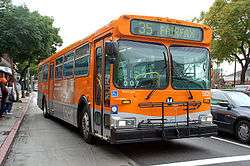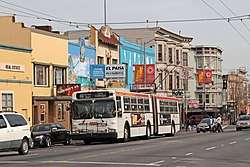New Flyer High Floor
The New Flyer High Floor was a line of conventional (high-floor) transit buses available in 35' rigid, 40' rigid, and 60' articulated lengths manufactured by New Flyer Industries between 1987 and 1996. The buses were powered by conventional diesel or natural gas engines using either V-drive or T-drive transmission couplings, with the exception of an articulated electric trolleybus variant manufactured for a single customer, the San Francisco Municipal Railway. The New Flyer Low Floor, a low-floor bus with a similar external appearance, was introduced in 1991 and proved to be more popular than the High Floor, which was discontinued in 1996 in diesel form. CNG high-floor buses continued to be built until 1999, and the articulated version was manufactured until early 2004.
| New Flyer High Floor | |
|---|---|
   Top: New Flyer D35HF (2018) Middle: C40[HF] (2008) Bottom: E60HF (articulated, 2013) | |
| Overview | |
| Manufacturer | New Flyer |
| Production |
|
| Body and chassis | |
| Class | Transit bus |
| Body style | semi-monocoque |
| Layout | RR |
| Powertrain | |
| Engine | |
| Transmission | |
| Dimensions | |
| Wheelbase | |
| Length | |
| Width | 102 in (2.59 m)[1][2][3][4][5] |
| Height | 121 1⁄2 to 128 in (3.09 to 3.25 m)[7][8] |
| Curb weight | |
| Chronology | |
| Predecessor | Flyer 700/800/900 series |
| Successor | New Flyer Low Floor |
Design
| Motive power | Nominal Length | Model | |||
|---|---|---|---|---|---|
| C | Compressed natural gas | 35 | 35 ft (nominal) | HF | High Floor (suffix added to distinguish from New Flyer Low Floor bus models) |
| D | Diesel | ||||
| 40 | 40 ft (nominal) | ||||
| E | Trolleybus electric (overhead catenary) | ||||
| 60 | 60 ft (articulated) | ||||
| L | Liquefied natural gas | ||||
For example, a New Flyer D40HF is a 40' (nominal) rigid high-floor bus with conventional diesel power. The "HF" suffix was added starting in the early 1990s to distinguish the earlier High Floor buses from the Low Floor buses, which were introduced in 1991. Prior to that time, the equivalent designation would simply be D40. The articulated D60/D60HF was nicknamed Galaxy.
The trolleybus was only made in a 60-foot articulated version (E60HF) for a single agency, Muni.[10]
The New Flyer High Floor uses a tubular side construction clad with either aluminum or fiberglass panels; wheel housings are made of stainless steel, and stepwells have the option of either stainless steel or fiberglass.[1][5] To reduce weight, the roof, front, and rear panels are made from fiberglass.[5] All buses are equipped with rear-mounted engines using either V- or T-drive couplings to the transmission driving the rear axle;[1] since the D60 articulated buses use the "pusher" configuration, the articulation joint is equipped with an anti-jackknifing feature.[5]
Deployment
The first New Flyer High Floor buses were model D40, delivered to the Toronto Transit Commission and Winnipeg Transit in 1987.[10] AC Transit was the first customer for the D35 (1988, along with Santa Cruz METRO) and the D60 articulated model (1989).[10] The first deliveries of natural gas-powered variants occurred in 1995: BC Transit, Los Angeles County Metropolitan Transportation Authority, and San Diego Metropolitan Transit System for the C40HF; Sun Metro (El Paso) for the L40HF.[10]
The only E60 trolleybus variants built were a fleet of 60 sold to San Francisco Municipal Railway (Muni) in 1993, that agency's first use of articulated trolleybuses.[11][12] The last of the E60s were retired in 2015.[13] The last E60 (Muni #7031) was briefly put up for auction in 2019[14] before Muni withdrew the auction at the request of interested preservation groups.[15]
Competition
References
- "New Flyer D40 High Floor Bus". New Flyer Industries. Archived from the original on April 11, 1997.
- "D35 High Floor". New Flyer Industries. Archived from the original on March 31, 2001.
- "40 High Floor". New Flyer Industries. Archived from the original on March 31, 2001.
- "New Flyer D60 Articulated High Floor Bus". New Flyer Industries. Archived from the original on April 11, 1997.
- "D60 High Floor". New Flyer Industries. Archived from the original on March 31, 2001.
- STURAA Test: New Flyer 40' Heavy Duty Bus from New Flyer Industries Limited (PDF) (Report). Pennsylvania Transportation Institute, Bus Testing and Research Center. February 1991. Retrieved March 13, 2019.
- STURAA Test: 12 Year 500,000 mile bus from New Flyer, Model D-40 (PDF) (Report). Pennsylvania Transportation Institute, Bus Testing and Research Center. March 1995. Retrieved March 13, 2019.
- STURAA Test: 12 Year 500,000 mile bus from New Flyer, Model D-60 (PDF) (Report). Pennsylvania Transportation Institute, Bus Testing and Research Center. November 1993. Retrieved March 13, 2019.
- STURAA Test: 40' Heavy Duty Bus from New Flyer (PDF) (Report). Pennsylvania Transportation Institute, Bus Testing and Research Center. July 1992. Retrieved March 13, 2019.
- "Customer List" (PDF). New Flyer Industries. Archived from the original (PDF) on August 24, 2000.
- 2010 SFMTA Transit Fleet Management Plan (PDF) (Report). San Francisco Municipal Transportation Agency. April 2011. Retrieved February 7, 2019.
- James, Robert F. (1993). "San Francisco Municipal Railway Articulated Trolley Coach Procurement". Journal of Commercial Vehicles. SAE International. 102: 647–660. JSTOR 44722970.
- Trolleybus Magazine No. 320 (March–April 2015), pp. 62–63.
- "1993 New Flyer Electric E60 Transit Bus". Archived from the original on May 29, 2019.
- Rodriguez, Joe Fitzgerald (May 29, 2019). "Transit enthusiasts rally to rescue 'rare' Muni bus headed for auction: 1994 New Flyer one of the last vehicles of its kind". San Francisco Examiner. Retrieved May 31, 2019.
| Wikimedia Commons has media related to New Flyer High Floor. |
External links
- "New Flyer Industries D35". Canadian Public Transit Discussion Board wiki. Retrieved December 11, 2018.
- "New Flyer Industries C40". Canadian Public Transit Discussion Board wiki. Retrieved December 11, 2018.
- "New Flyer Industries D40". Canadian Public Transit Discussion Board wiki. Retrieved December 11, 2018.
- "New Flyer Industries L40". Canadian Public Transit Discussion Board wiki. Retrieved December 11, 2018.
- "New Flyer Industries D60". Canadian Public Transit Discussion Board wiki. Retrieved December 11, 2018.
- "New Flyer Industries E60". Canadian Public Transit Discussion Board wiki. Retrieved December 11, 2018.